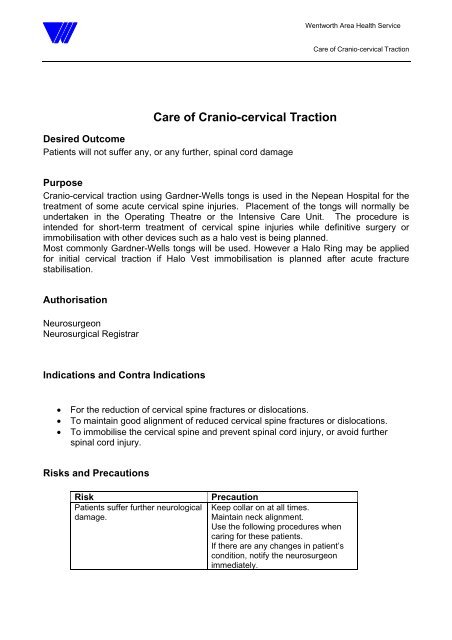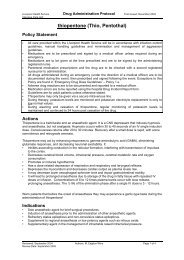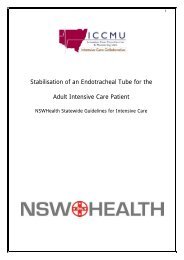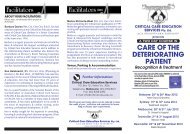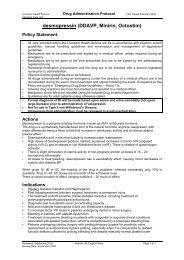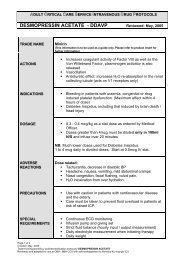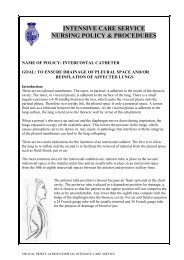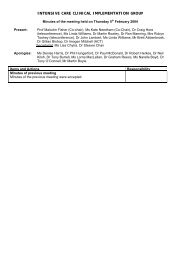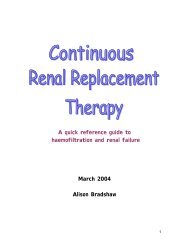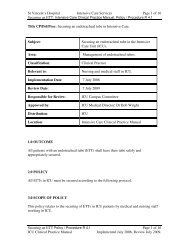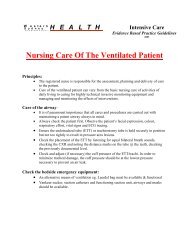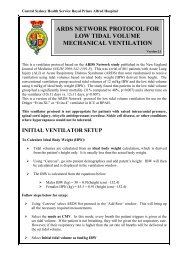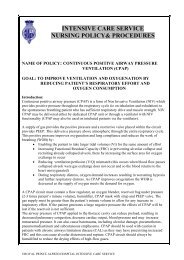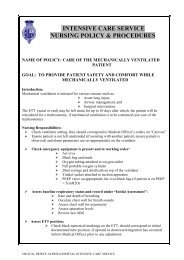Care of Cranio-cervical Traction - Intensive Care & Coordination ...
Care of Cranio-cervical Traction - Intensive Care & Coordination ...
Care of Cranio-cervical Traction - Intensive Care & Coordination ...
You also want an ePaper? Increase the reach of your titles
YUMPU automatically turns print PDFs into web optimized ePapers that Google loves.
<strong>Care</strong> <strong>of</strong> <strong>Cranio</strong>-<strong>cervical</strong> <strong>Traction</strong><br />
Desired Outcome<br />
Patients will not suffer any, or any further, spinal cord damage<br />
Wentworth Area Health Service<br />
<strong>Care</strong> <strong>of</strong> <strong>Cranio</strong>-<strong>cervical</strong> <strong>Traction</strong><br />
Purpose<br />
<strong>Cranio</strong>-<strong>cervical</strong> traction using Gardner-Wells tongs is used in the Nepean Hospital for the<br />
treatment <strong>of</strong> some acute <strong>cervical</strong> spine injuries. Placement <strong>of</strong> the tongs will normally be<br />
undertaken in the Operating Theatre or the <strong>Intensive</strong> <strong>Care</strong> Unit. The procedure is<br />
intended for short-term treatment <strong>of</strong> <strong>cervical</strong> spine injuries while definitive surgery or<br />
immobilisation with other devices such as a halo vest is being planned.<br />
Most commonly Gardner-Wells tongs will be used. However a Halo Ring may be applied<br />
for initial <strong>cervical</strong> traction if Halo Vest immobilisation is planned after acute fracture<br />
stabilisation.<br />
Authorisation<br />
Neurosurgeon<br />
Neurosurgical Registrar<br />
Indications and Contra Indications<br />
• For the reduction <strong>of</strong> <strong>cervical</strong> spine fractures or dislocations.<br />
• To maintain good alignment <strong>of</strong> reduced <strong>cervical</strong> spine fractures or dislocations.<br />
• To immobilise the <strong>cervical</strong> spine and prevent spinal cord injury, or avoid further<br />
spinal cord injury.<br />
Risks and Precautions<br />
Risk Precaution<br />
Patients suffer further neurological<br />
damage.<br />
Keep collar on at all times.<br />
Maintain neck alignment.<br />
Use the following procedures when<br />
caring for these patients.<br />
If there are any changes in patient’s<br />
condition, notify the neurosurgeon<br />
immediately.
Resources<br />
Neurosurgeon<br />
Neurosurgical Registrar<br />
Senior Medical Officer<br />
Senior Registered Nurse<br />
Steps<br />
Procedure Rationale<br />
The procedure will usually be performed<br />
by the Neurosurgeon, in the <strong>Intensive</strong><br />
<strong>Care</strong> Unit or in the Operating Theatre. It<br />
is performed under local anaesthetic,<br />
although light sedation may be required.<br />
The patient will need to be placed onto a<br />
“traction” bed, and informed consent<br />
must be obtained. After clipping the hair<br />
at the insertion site, the area is<br />
anaesthetised and a small cut made into<br />
the skin on both sides <strong>of</strong> the head<br />
(usually 4cms above the external<br />
auditory meatus). The Tongs are then<br />
screwed into place and traction applied<br />
as ordered by the Neurosurgeon.<br />
As previously mentioned, the patient<br />
must be transferred to a “traction” bed.<br />
This must be done using the Jordan<br />
Frame, registrar and four other people.<br />
The registrar will support the head and<br />
neck while two staff stabilise the frame<br />
while in the air, one staff to move out the<br />
ICU bed and replace it with the traction<br />
bed, and one staff to work the lifter.<br />
Once the tongs are in situ, care must be<br />
taken with the tongs.<br />
The pin sites should be cleaned with half<br />
strength Chlorhexidine/Normal Saline<br />
daily and left uncovered if dry If the pin<br />
sites are moist then cover them with dry<br />
gauze.<br />
The two “locking” nuts should be checked<br />
at least twice a day to ensure they are<br />
firmly screwed on.<br />
The spring-loaded pin on one side should<br />
be protruding 1 to 2 mm from the centre.<br />
This should be checked at least twice a<br />
Wentworth Area Health Service<br />
<strong>Care</strong> <strong>of</strong> <strong>Cranio</strong>-<strong>cervical</strong> <strong>Traction</strong><br />
Using the Jordan lifter is the safest way<br />
to move these patients. The registrar will<br />
support the neck to prevent movement<br />
that may cause spinal damage.<br />
This is to reduce the risk <strong>of</strong> infection.<br />
This is to prevent the tongs’ screws from<br />
loosening.<br />
This pin should be checked because if<br />
loose, could lead to the traction slipping<br />
and the tongs tearing the scalp. Also
Wentworth Area Health Service<br />
<strong>Care</strong> <strong>of</strong> <strong>Cranio</strong>-<strong>cervical</strong> <strong>Traction</strong><br />
Procedure Rationale<br />
day. If this pin is not protruding 1 to 2 mm traction will be lost leading potentially to<br />
then the tongs are too loose.<br />
spinal cord injury.<br />
The traction itself will be set up by either This to ensure the traction is set up<br />
the Neurosurgeon or senior<br />
correctly, and to reduce the risk <strong>of</strong> spinal<br />
Physiotherapist. The Neurosurgeon cord damage.<br />
should apply the initial weight to the<br />
traction. Any further modifications to the<br />
traction set up should be ordered and<br />
documented in the progress notes by the<br />
Neurosurgeon and carried out by either<br />
the Neurosurgeon himself, a senior<br />
Physiotherapist or by a senior member <strong>of</strong><br />
the Nursing staff<br />
For simple <strong>cervical</strong> immobilisation 10lbs<br />
(4.5kg) <strong>of</strong> weight is usually sufficient. For<br />
reduction <strong>of</strong> fracture or dislocation, an<br />
initial weight <strong>of</strong> 10lbs is used and<br />
increments <strong>of</strong> 5lbs (2.2kg) are added.<br />
This will vary from patient to patient and<br />
will be ordered by the Neurosurgeon and<br />
documented in the progress notes<br />
Directly after the initial traction is applied, This is to check that the traction applied<br />
and between any addition <strong>of</strong> weight, the is correct for that patient, and that the<br />
<strong>cervical</strong> spine should be x-rayed and <strong>cervical</strong> is in the alignment required.<br />
careful assessment <strong>of</strong> the patient’s<br />
neurological status attended.<br />
Ensure the weight is hanging freely. To ensure the patient is receiving the<br />
correct traction that was order by the<br />
Neurosurgeon.<br />
Ensure the ropes are knotted firmly and This is to prevent the traction from<br />
ends taped.<br />
coming undone.<br />
Ensure counter-traction is applied (the<br />
entire bed may be tipped slightly)<br />
Ensure the angle <strong>of</strong> pull is as directed by The position <strong>of</strong> the pins and the direction<br />
the Neurosurgeon.<br />
<strong>of</strong> the pull will decide if the patient’s neck<br />
is in slight flexion or slight extension.<br />
More commonly the neck will be held in a<br />
neutral position. This will be determined<br />
by the Neurosurgeon.<br />
Patients having <strong>cervical</strong> traction placed, Spinal Shock represents loss <strong>of</strong> reflex,<br />
or who already have the traction in place motor, sensory and autonomic activity<br />
should be carefully monitored for below the level <strong>of</strong> the spinal cord injury.<br />
changes in motor or sensory function. The heart rate and blood pressure will fall<br />
and parts <strong>of</strong> the body below the level <strong>of</strong><br />
the lesion are paralysed and without<br />
sensation. This can be assessed<br />
Motor function should be tested by Any change could mean dislodgement <strong>of</strong>
Procedure Rationale<br />
assessing strength and movement <strong>of</strong> all<br />
limbs, using the Nepean Hospital<br />
Neurological Observation Chart.<br />
Sensory function should be assessed by<br />
lightly pinching the patient’s skin, or<br />
lightly dabbing with ice, starting at the<br />
shoulder level and working down both<br />
sides <strong>of</strong> the extremities. Record the<br />
highest level <strong>of</strong> function on each side.<br />
Ask the patient to close their eyes during<br />
the examination.<br />
If there are any major changes in the<br />
previously mentioned observations, there<br />
should be immediate notification <strong>of</strong> the<br />
Neurosurgical team. If prompt<br />
assessment by the Neurosurgeon is not<br />
available call 42222 and ask for the<br />
Medical Emergency Team.<br />
Patients undergoing reduction <strong>of</strong> <strong>cervical</strong><br />
fracture or dislocation can usually be<br />
lifted using a Jordan frame and lifter, with<br />
inline traction maintained. If the traction<br />
weight is removed then a <strong>cervical</strong> collar<br />
should be applied, the neck immobilised<br />
with sandbags, and manual traction<br />
maintained by a senior medical staff or<br />
senior registered nurse. Confirm with the<br />
neurosurgeon if this is appropriate for the<br />
patient.<br />
For patients whose <strong>cervical</strong> spine is<br />
simply being immobilised (i.e. a fracture<br />
is not being reduced) a hard collar can be<br />
applied, traction removed, and the patient<br />
can be log rolled or lifted on a Jordan<br />
frame in the standard way. Supervision<br />
by a senior medical <strong>of</strong>ficer or senior<br />
registered nurse is required. Confirm with<br />
the neurosurgeon if this is appropriate for<br />
the patient.<br />
Most patients in <strong>cervical</strong> traction can be<br />
safely log rolled without removing<br />
traction, but alignment <strong>of</strong> head, neck and<br />
body must be maintained. Supervision <strong>of</strong><br />
this alignment should be undertaken by a<br />
senior medical <strong>of</strong>ficer or a senior<br />
registered nurse. Confirm with<br />
neurosurgeon if this is appropriate for the<br />
Wentworth Area Health Service<br />
<strong>Care</strong> <strong>of</strong> <strong>Cranio</strong>-<strong>cervical</strong> <strong>Traction</strong><br />
the traction and alignment <strong>of</strong> the neck,<br />
leading to neurological deficit. Using the<br />
chart standardises the assessments.<br />
Any change could mean dislodgement <strong>of</strong><br />
the traction and alignment <strong>of</strong> the neck,<br />
leading to neurological deficit.<br />
Each side needs to be recorded, as there<br />
may be unilateral sensory function loss.<br />
Delay in assessing changes in a patient<br />
with a <strong>cervical</strong> spine fracture can lead to<br />
quadriplegia, respiratory and cardiac<br />
arrest.<br />
If the patient with a <strong>cervical</strong> spine fracture<br />
is moved in an unsafe manner, damage<br />
to the <strong>cervical</strong> spine and quadriplegia<br />
may result.<br />
If the patient whose <strong>cervical</strong> spine is<br />
being immobilised is moved in an unsafe<br />
manner, damage to the <strong>cervical</strong> spine<br />
and quadriplegia may result.<br />
If the patient whose <strong>cervical</strong> spine is<br />
being immobilised, is moved in an unsafe<br />
manner, damage to the <strong>cervical</strong> spine<br />
and quadriplegia may result.
Procedure Rationale<br />
patient.<br />
A “hard” collar <strong>of</strong> the correct size for the<br />
patient should be available at the bedside<br />
<strong>of</strong> every patient in <strong>cervical</strong> traction.<br />
Wentworth Area Health Service<br />
<strong>Care</strong> <strong>of</strong> <strong>Cranio</strong>-<strong>cervical</strong> <strong>Traction</strong><br />
If any movement <strong>of</strong> the patient is<br />
required, or any problems with the<br />
traction occur the hard collar is easily<br />
accessible to place on patient.<br />
References<br />
McCarthy, L. 1998 Safe handling <strong>of</strong> patients on <strong>cervical</strong> traction. Nursing Times 94,<br />
14, 57-59.<br />
Smeltzer, S.C., and Bare, B.G. 2000 Brunner and suddarth’s textbook <strong>of</strong> medicalsurgical<br />
nursing. 9 th ed, Lippincott, Philadelphia.<br />
Unit 14 “Neurologic Function” pages 1688-1694<br />
Cotler, J.M., Herbison, G.H., Nasuti, J.J., Ditunno, J.F., An, H. and Wolff, B.E. 1993.<br />
Closed reduction <strong>of</strong> traumatic spine dislocation using traction weights up to 140<br />
pounds. Spine. 18, 3, 386-390.<br />
Choo, J.H.N., Liu, W.Y. and Kumar, V.P. 1996. Complications from Gardner-Wells tongs.<br />
Injury 27, 7, 512-513.<br />
AUTHORISED BY A McLean, V McCartan<br />
COMMITTEE<br />
RESPONSIBLE<br />
ICU Management Committee<br />
DATE REVISED December 2004<br />
DATE EFFECTIVE December 2006<br />
REVIEW DATE December 2006


